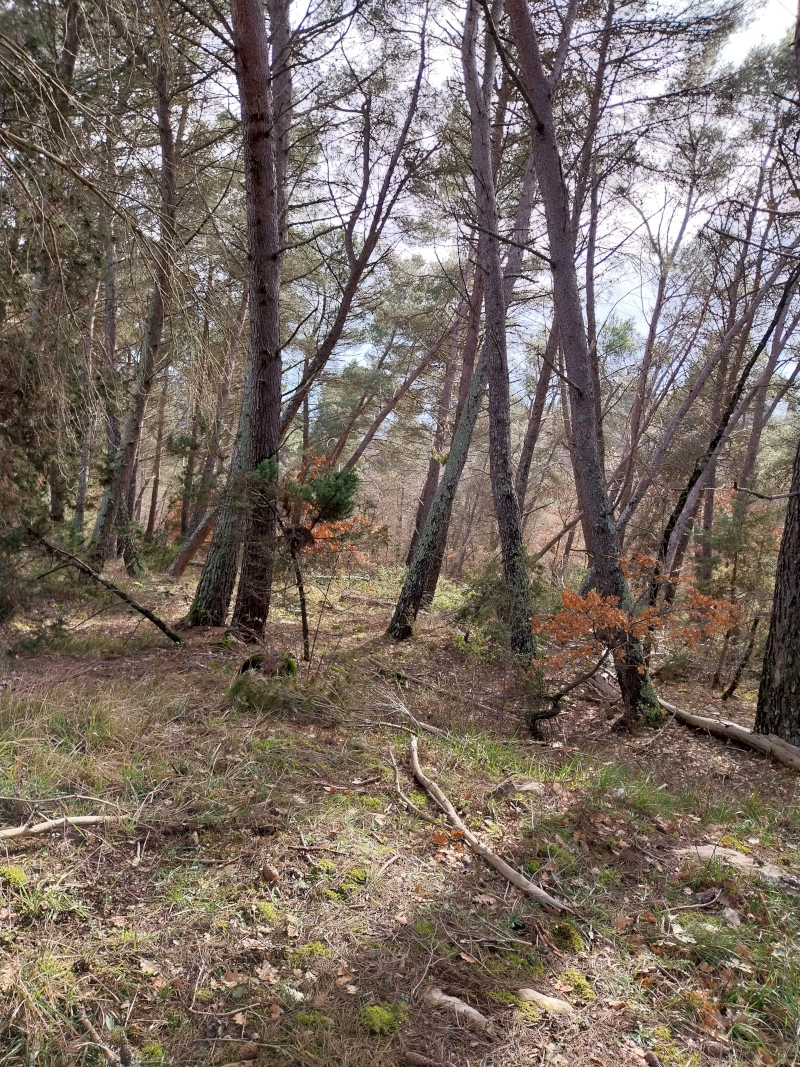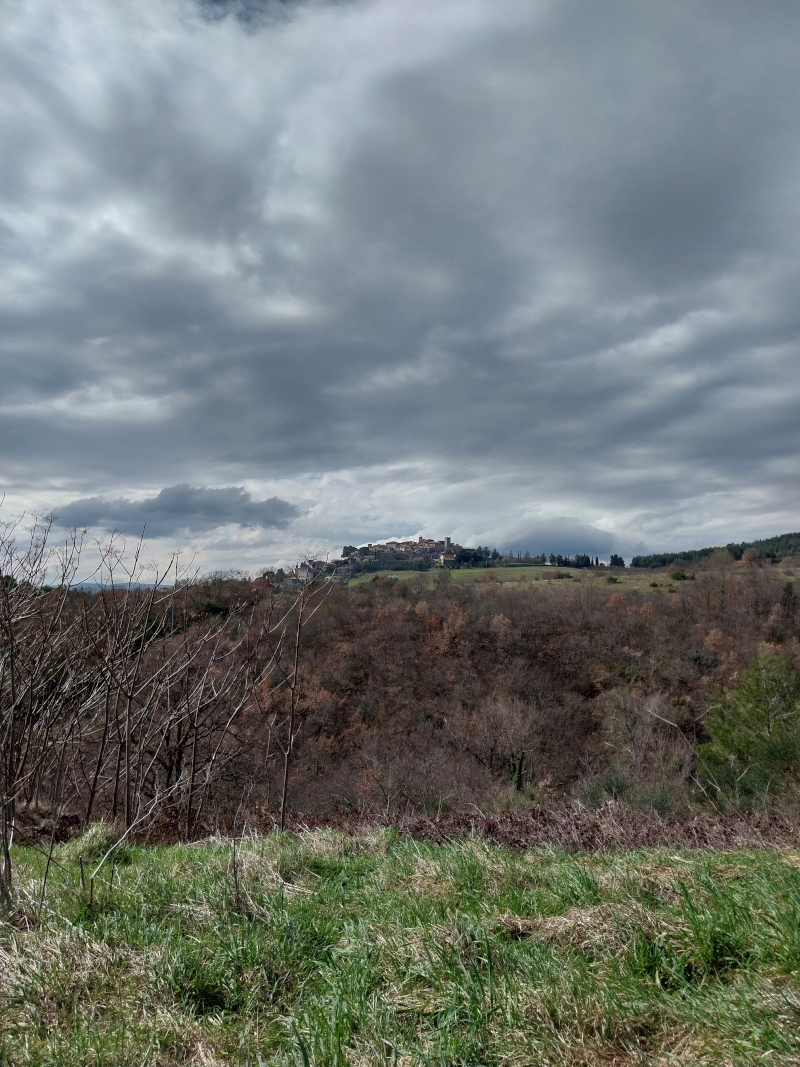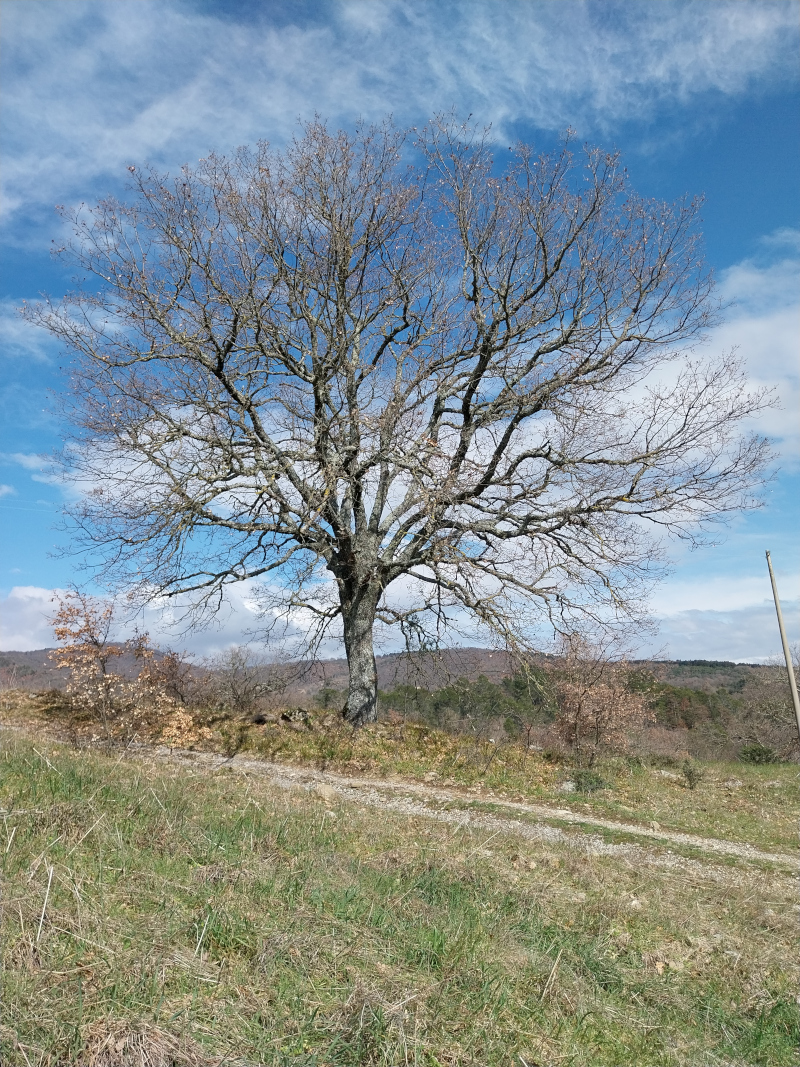TR Montegabbione
COD: A0016



Comprare 90 ettari di bosco abbandonato: una scelta per domani
Ho acquistato nel gennaio del 2023 un fondo agricolo di 124 ettari, di cui 90 ettari di bosco. Lo scopo è di gestirlo assieme al mio compagno nella speranza che diventi un giorno un bosco ricco di biodiversità e con alberi ad alto fusto.
Il terreno è una lunga striscia di terreno che parte da 400 metri di altitudine per arrivare a 800 metri. In mezzo a questa striscia c’è un altipiano con un bellissimo panorama: si vede il borgo di Montegabbione e tante colline intorno. Si tratta di un fondo agricolo abbandonato da 20 anni dove oltre al bosco c’erano seminativi e pascoli arborati.
Ad oggi quel bosco non è per niente bello.
Un’ampia zona è dominata da pini d’Aleppo. Sono stati piantati nell’ambito di iniziative di rimboschimento fatte male, nel dopo guerra. Sono troppo fitti e hanno tutti la stessa età. Il sottobosco è molto povero, ci si vedono piccolissime querce che stentano a crescere. I pini sono adesso in fine di vita vegetativa e stanno morendo in piedi tutti insieme.
In un'altra zona, scoscesa, c’è un cosiddetto “bosco ceduo”: alberi tutti della stessa specie e della stessa età coltivati per produrre legna. Nei boschi cedui, gli alberi sono tagliati ogni 15-30 anni. Nuovi alberi tutti uguali ricrescono da piccoli rami che si sviluppano alla base dei ceppi che rimangono (i polloni). Nel nostro caso, a circa 15 anni dall’ultimo taglio, si può vedere un sottobosco tipico da bosco ceduo, poverissimo.
Lì dove invece ti si apre il cuore è nella zona in cui, in mezzo ai rovi, scopri alcune querce secolari. Sotto di loro ci sono alberelli vari con i quali dobbiamo ancora fare conoscenza anche perché non ne conosciamo neanche il nome!
Perché comprare un bosco del genere? Per tanti motivi.
-
Per contribuire alla sequestrazione del CO2
Questa è stata la nostra prima motivazione, contribuire alla cosiddetta “mitigazione” della crisi climatica in atto. Si tratta di contrastare l’emissione di gas ad effetto serra. Sono ormai 20 anni che provo a contribuire alla riduzione delle emissioni di questi gas puntando sulla modifica dei comportamenti individuali come mangiare meno carne e non prendere l’aereo. Il mio compagno invece lotta da quando è ragazzo per cambiamenti radicali delle politiche ambientali. Abbiamo capito che adesso non bastano più i piccoli gesti e che non possiamo aspettare che gli uomini e le donne politiche prendano coscienza del problema. Non c’è più tempo. Abbiamo quindi deciso di sostenere quelli che sono tra i nostri alleati più preziosi: gli alberi. Sappiamo che i boschi, con i loro alberi e il loro suolo, sequestrano parte del CO2 in eccesso nell’atmosfera. Ebbene il nostro intento è aiutarli ad aiutarci. -
Per preparare i boschi alla crisi climatica in atto
Si chiama “resilienza” la capacità a resistere; nello specifico la capacità delle piante a resistere alla crisi climatica. E’ indispensabile potenziare la resilienza dei boschi per contrastare la desertificazione dei Paesi Mediterranei come il nostro. Nel bosco che abbiamo comprato vogliamo accompagnare la crescita di alberi locali (autoctoni) resistenti alla siccità. Vogliamo anche contribuire a creare un suolo più ricco che resisti ad eventi climatici estremi come le piogge torrenziali. -
Per contribuire alla preservazione della biodiversità
Un’elevata biodiversità (cioè la presenza di una grande varietà di piante, animali e funghi nello stesso luogo) permette ai boschi di resistere meglio alle malattie e agli eventi estremi. Questo succede soprattutto con piante locali. Vogliamo preservare la biodiversità del bosco anche come ricchezza in sé e per sé, perché è bella e perché è necessaria per mantenere la vita sulla terra. Aiuteremo quindi la crescita di alberi di varie specie e varietà locali. -
Per produrre cibo negli anni a venire
Siamo consci dei problemi di sicurezza alimentare e cioè di mancanza di cibo che ci saranno nei Paesi Mediterranei in un futuro molto vicino. Oltre al bosco cureremo e pianteremo quindi alberi che producano cibo. Riporteremo al suo potenziale produttivo un uliveto abbandonato da 20 anni. Pianteremo un frutteto utilizzando solo varietà locali. Per adesso non abbiamo le forze per riportare in produzione i seminativi abbandonati ma chissà?… Sarebbe bello vederci campi con una varietà di cereali antichi resistenti alla siccità. -
Per fare didattica nel bosco e partecipare ad un movimento
Una volta avviati i lavori, pensiamo che questo terreno possa diventare un bosco didattico. Un bosco in crescita, in cammino per diventare un bosco bello. Un luogo in cui dialogare con persone della regione su come lavorare localmente, concretamente, con l’aiuto dei boschi, per contrastare i cambiamenti climatici, per la protezione della biodiversità, per ricreare bellezza. Speriamo anche che questo bosco possa essere fonte d’ispirazione per chi ne possiede uno ma ha pensato fino ad oggi che sia di poco valore. Speriamo di poter collaborare con altre persone, associazioni, istituzioni che fanno la stessa nostra scelta e di farlo con visibilità così da trascinare altri. Siamo incoraggiati dal fatto che quello che vogliamo fare è esattamente quello che le istituzioni europee sostengono, anche tramite finanziamenti significativi. -
Per viverci
Avevamo pensato di compare un bosco ceduo e lasciarlo crescere ma anche solo vederlo ci metteva tristezza. I boschi cedui appena tagliati sembrano campi di battaglia in cui sono rimaste solo alcuni alberi non tagliati isolati (le matricine) e quei monchi dai quali cresceranno nuovi alberi. Abbiamo capito che volevamo un bosco che necessiti di un aiuto ma che abbia in se un potenziale di biodiversità. Abbiamo capito che volevamo viverci. Non lo vedremo ad alto fusto ma speriamo che chi viene dopo di noi lo vedrà.
Che interventi faremo sul bosco?
Né io né il mio compagno abbiamo competenze in tema di bosco! Magari in questo testo abbiamo pure scritto stupidaggini che correggeremo man mano che avremo acquisito più conoscenze. Vogliamo ridurre al minimo il rischio di errori e quindi chiederemo ad un dottore agro-forestale di stilare un piano di gestione forestale del bosco. Ci hanno già detto che gran parte del lavoro sarà semplicemente lasciare che il bosco cresca da solo! Saranno effettuati lavori per mettere in sicurezza il bosco rispetto agli incendi. Piano piano saranno estirpati i pini d’Aleppo che stanno morendo, in modo da lasciare crescere una varietà di altri alberi locali. Gli alberi non saranno tagliati per motivi commerciali ma il legno tagliato sarà utilizzato da noi, regalato o venduto, nella misura del possibile anche come materiale di costruzione.
Come siamo arrivati al Fondo Forestale Italiano?
Semplicemente girando su internet alla ricerca di idee per sequestrare CO2 tramite gli alberi. Abbiamo letto la motivazione di uno dei soci del Fondo Forestale Italiano che ha comprato un terreno abbandonato in Abruzzo e lo ha affiliato al Fondo Forestale Italiano. Abbiamo visto che anche lui era stato ispirato dal libro di Giono “L’uomo che piantava alberi” e dal documentario di Sebastião Salgado “Il sale della terra”.
Allora abbiamo capito che eravamo arrivati nel posto giusto e abbiamo deciso di affiliare questo bosco.

